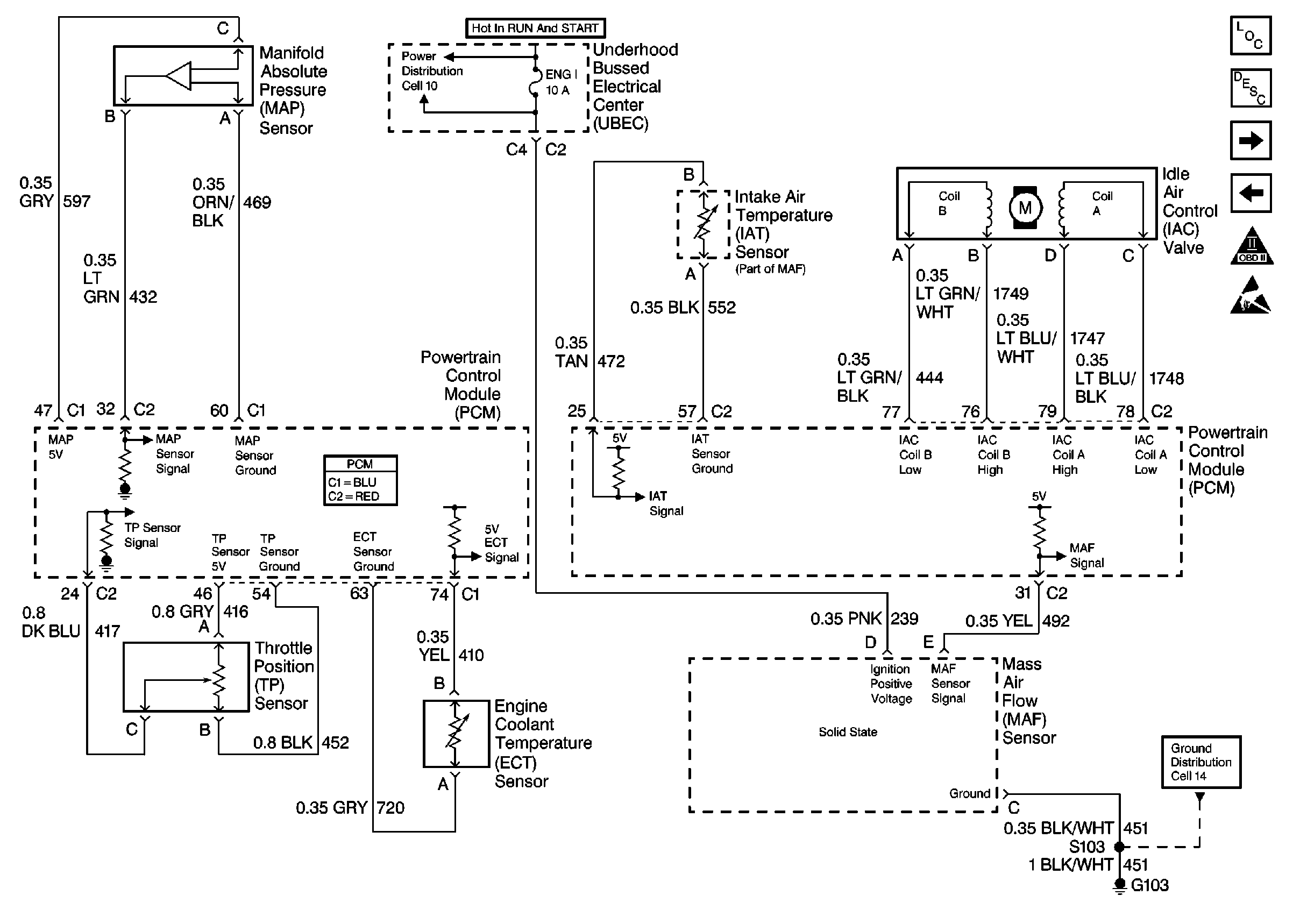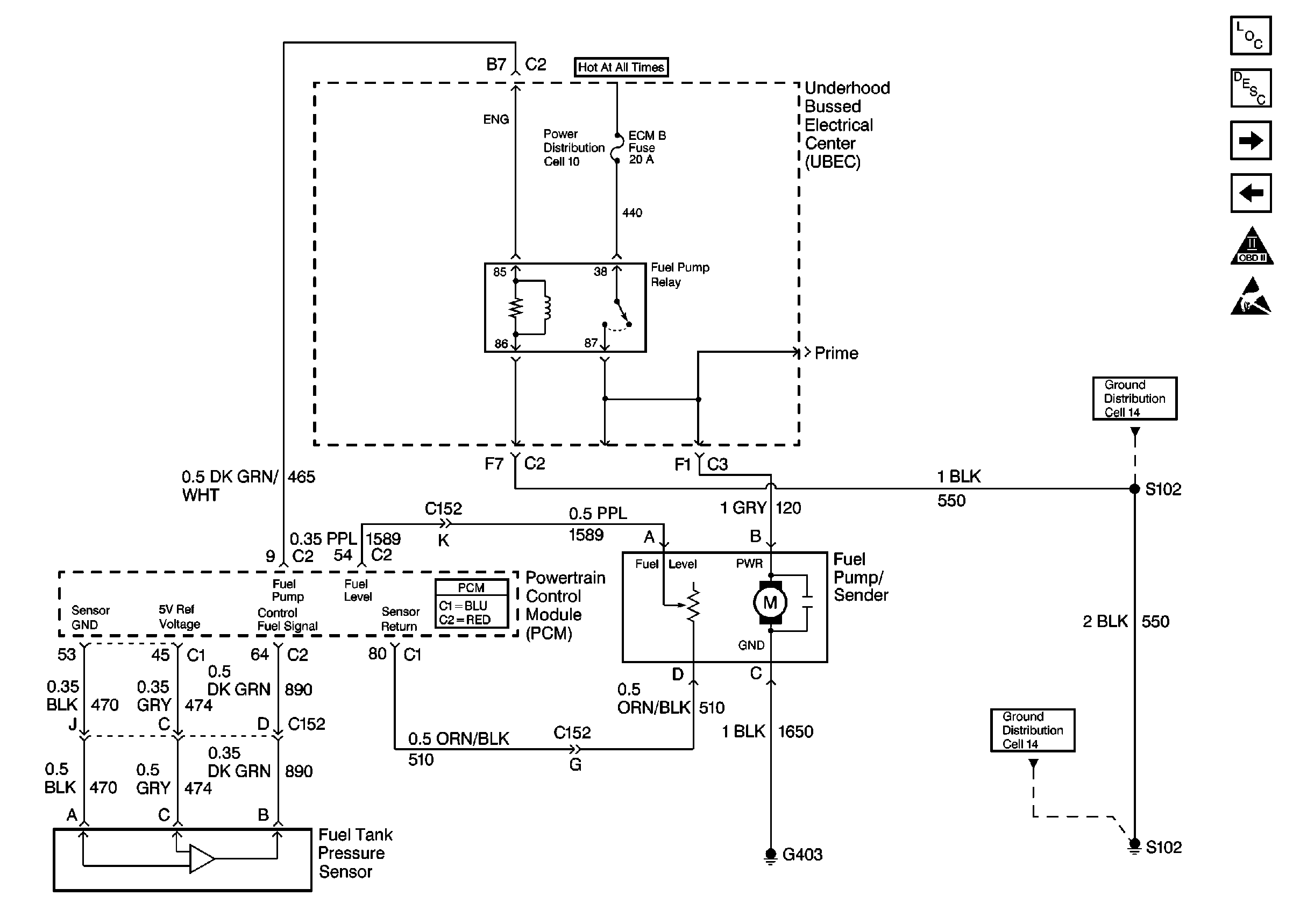
Circuit Description
The powertrain control module (PCM) uses a common 5 volt reference 1 circuit as a sensor feed. This circuit supplies 5 Volts to the following sensors:
| • | The manifold absolute pressure (MAP) sensor |
| • | The exhaust gas recirculation (EGR) valve |
The PCM monitors the voltage on the 5 volt reference 1 circuit. This DTC sets if the voltage is out of range.
This diagnostic trouble code (DTC) sets if the 5 volt reference circuit is shorted to ground. When the 5 volt reference circuit or signal circuits are shorted to a voltage both P1635 and P1639 set. The following components or circuits need to be inspected:
| • | MAP sensor |
| • | EGR valve |
| • | Throttle position (TP) sensor |
| • | Fuel level sensor |
| • | Fuel tank pressure sensor |
Conditions for Running the DTC
The ignition switch is in the RUN position.
Conditions for Setting the DTC
| • | The 5 volt reference circuit is out of range. |
| • | All above conditions are present for more than 2 seconds. |
Action Taken When the DTC Sets
| • | The PCM illuminates the malfunction indicator lamp (MIL) on the second consecutive ignition cycle that the diagnostic runs and fails. |
| • | The PCM records the operating conditions at the time the diagnostic fails. The first time the diagnostic fails, the PCM stores this information in the Failure Records. If the diagnostic reports a failure on the second consecutive ignition cycle, the PCM records the operating conditions at the time of the failure. The PCM writes the conditions to the Freeze Frame and updates the Failure Records. |
Conditions for Clearing the MIL/DTC
| • | The PCM turns OFF the malfunction indicator lamp (MIL) after 3 consecutive ignition cycles that the diagnostic runs and does not fail. |
| • | A last test failed, or current DTC, clears when the diagnostic runs and does not fail. |
| • | A history DTC clears after 40 consecutive warm-up cycles, if no failures are reported by this or any other emission related diagnostic. |
| • | Use a scan tool in order to clear the MIL and the DTC. |
Diagnostic Aids
Important: Remove any debris from the PCM connector surfaces before servicing the PCM. Inspect the PCM connector gaskets when diagnosing or replacing the PCM. Ensure that the gaskets are installed correctly. The gaskets prevent water intrusion into the PCM.
Using the Freeze Frame and Failure Records data may aid in locating an intermittent condition. If you cannot duplicate the DTC, the information included in the Freeze Frame and/or Failure Records data can help determine how many miles since the DTC set. The Fail Counter and Pass Counter can also help determine how many ignition cycles the diagnostic reported a pass and a fail. Operate the vehicle within the same Freeze Frame conditions such as RPM, load, vehicle speed, temperature etc. that you observed. This will isolate when the DTC failed. For an intermittent condition, refer to Symptoms .
Test Description
The numbers below refer to the step numbers on the diagnostic table.
-
The 5 volt reference circuits for the sensors are connected together inside the PCM. Both DTCs P1635 and P1639 set at the same time indicates a 5 volt reference circuit is shorted to a voltage.
-
The 5 volt reference circuits for the sensors are connected together inside the PCM. When only P1635 is set, this indicates a short to ground on one of the 5 volt reference circuits.
-
This step isolates the 5 volt reference circuit from the sensor signal circuit.
-
This step determines if the 5 volt reference circuits or the fuel level sensor signal circuit are only shorted when the fuel pump is enabled. You may have to enable the fuel pump a couple of times to see if the voltages increase. Inspect the fuel pump harness thoroughly for being shorted to the fuel tank pressure sensor or the fuel level sensor.
-
The 5 volt reference circuits may be shorted to another PCM circuit. The shorted circuit may not be apparent when the PCM harness connector is disconnected. Testing continuity from each 5 volt reference circuit isolates the shorted circuit.
Step | Action | Value(s) | Yes | No | ||||||||||||||||||||
|---|---|---|---|---|---|---|---|---|---|---|---|---|---|---|---|---|---|---|---|---|---|---|---|---|
1 | Did you perform the Powertrain On-Board Diagnostic (OBD) System Check? | -- | ||||||||||||||||||||||
Did both DTCs P1635 and P1639 fail this ignition? | -- | |||||||||||||||||||||||
Did DTC P1635 fail this ignition? | -- | |||||||||||||||||||||||
4 |
Important: If DTCs P1635 and P1639 set refer to step 5. If only DTC P1635 sets, refer to step 9.
Does the scan tool indicate that DTC P1635 or P1639 set this ignition? | -- | Go to Diagnostic Aids | |||||||||||||||||||||
While idling the engine, monitor the voltages for the following sensors:
Does the scan tool display any of the voltages at or above the specified value? | 5 V | |||||||||||||||||||||||
Does any of the voltages increase when the fuel pump was turned ON? | -- | |||||||||||||||||||||||
7 |
Do any of the circuits measure more than the specified value? | 5.1 V | ||||||||||||||||||||||
|
Important:
Do any of the circuits indicate a resistance within the specified range? | 0-2 ohms | |||||||||||||||||||||||
9 |
Important: For detailed circuit information, refer to
Does the test lamp illuminate for any of the circuits? | -- | ||||||||||||||||||||||
10 | Test continuity from each 5 volt reference circuit to all other PCM circuits at the PCM harness connector using the DMM. Example: probe one lead to the MAP sensor 5 volt reference at the PCM harness connector circuit and probe the other lead to each terminal at the PCM harness connector. This must be performed for each 5 volt reference circuit. Refer to Testing for Continuity in Wiring Systems. Do any of the circuits indicate a resistance within the specified range? | 0-2 ohms | ||||||||||||||||||||||
11 | Repair the short between the fuel pump circuit and the appropriate 5 volt reference circuit or signal circuit. Refer to Wiring Repairs in Wiring Systems. Is the action complete? | -- | -- | |||||||||||||||||||||
12 | Repair the short to voltage on the appropriate 5 volt reference circuit. Refer to Wiring Repairs in Wiring Systems. Is the action complete? | -- | -- | |||||||||||||||||||||
13 | Repair the short between the appropriate 5 volt reference circuit and the PCM circuit that had continuity. Refer to Wiring Repairs in Wiring Systems. Is the action complete? | -- | -- | |||||||||||||||||||||
14 | Repair the short to ground on the appropriate 5 volt reference circuit. Refer to Wiring Repairs in Wiring Systems. Is the action complete? | -- | -- | |||||||||||||||||||||
15 |
Important:: Program the replacement PCM. Replace the PCM. Refer to Powertrain Control Module Replacement . Is the action complete? | -- | -- | |||||||||||||||||||||
16 | Repair the short to voltage on the appropriate signal circuit. Refer to Wiring Repairs in Wiring Systems. Is the action complete? | -- | -- | |||||||||||||||||||||
17 |
Does the scan tool indicate that this test ran and passed? | -- | ||||||||||||||||||||||
18 | Select the Capture Info option and the Review Info option using the scan tool. Are any DTCs displayed that you have not diagnosed? | -- | Go to the applicable DTC table | System OK |


